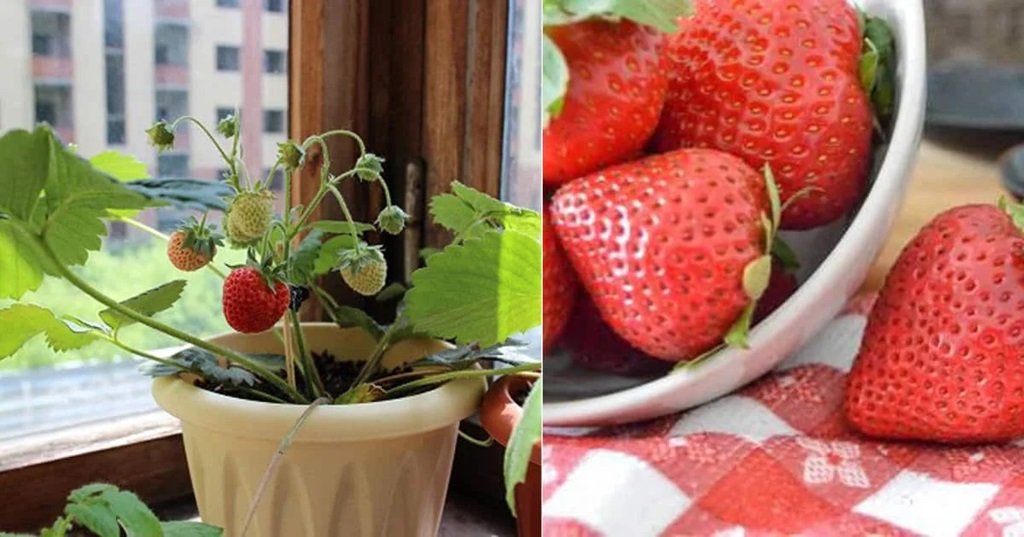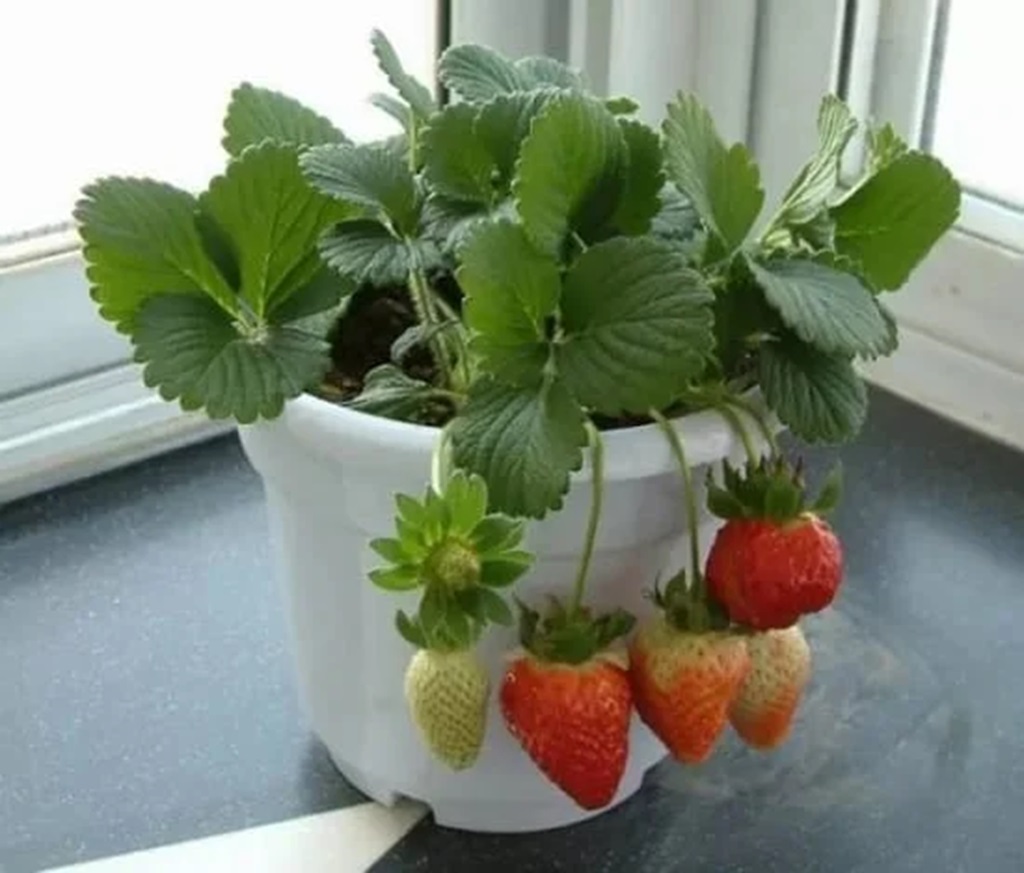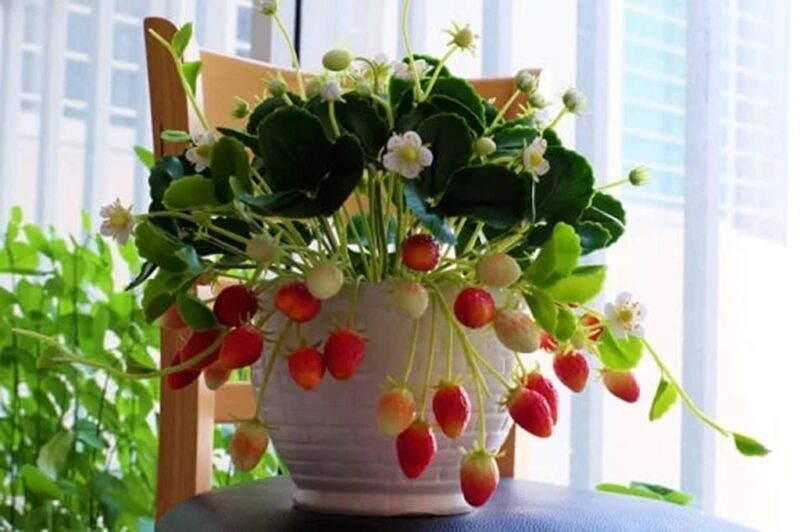Growing strawberries indoors is possible with proper temperature, lighting, and care to ensure successful cultivation in small spaces. When it comes to growing strawberries indoors, it is an achievable task with the right conditions and care.
With their sweet and juicy flavor, strawberries can be a delightful addition to any indoor garden. Whether you have limited outdoor space or simply want to enjoy fresh strawberries all year round, growing them indoors can be a rewarding experience.
We will explore the essential requirements and steps to successfully grow strawberries indoors. From choosing the right strawberry variety to optimizing temperature, lighting, and proper care, this guide will help you create an ideal environment for your indoor strawberry garden. So, let’s dive in and discover how to grow strawberries indoors successfully.
Choosing The Right Strawberry Varieties

Growing strawberries indoors is a fantastic way to savor fresh and delicious berries throughout the year. One key aspect of successful indoor strawberry cultivation is selecting the appropriate varieties. In this context, https://aliceswonderlandnursery.com/ suggests focusing on two main types of strawberries suitable for indoor growth: day-neutral varieties and everbearing varieties. Each of these types offers unique characteristics and advantages for indoor gardening, ensuring a bountiful harvest and flavorful fruits. Day-neutral strawberries can produce fruit continuously under the right conditions, regardless of the length of daylight.
On the other hand, everbearing varieties typically yield two to three harvests throughout the growing season, offering a more spread-out production. Both types are excellent choices for indoor gardeners looking to enjoy home-grown strawberries.
Consider Day-neutral Varieties
Day-neutral strawberry varieties are known for their ability to produce fruit continuously throughout the growing season, regardless of day length. These varieties are particularly well-suited for indoor cultivation as they do not require a specific amount of daylight to initiate fruiting. Day-neutral strawberries typically have smaller plants, making them easier to grow in containers. Their compact size also allows for efficient utilization of indoor gardening space.
One popular day-neutral variety is the “Albion” strawberry. Albion strawberries are known for their excellent flavor and high yield. They produce large, juicy berries that are perfect for fresh eating or use in desserts. Another popular day-neutral variety is “Seascape,” which offers a sweet and tangy flavor.
Consider the following benefits of day-neutral strawberry varieties:
- Continuous fruit production throughout the growing season.
- Smaller plant size for easy container gardening.
- Delicious flavor options like Albion and Seascape.
Evaluate Everbearing Varieties
Everbearing strawberries, as the name suggests, produce fruit multiple times during the year. Unlike day-neutral varieties, everbearing varieties are influenced by day length, which means they may not produce fruit during the winter months without supplemental lighting. However, with proper indoor conditions, everbearing strawberries can provide a steady supply of berries for your enjoyment.
The “Ozark Beauty” variety is a popular choice among gardeners due to its exceptional flavor and large fruit size. It thrives in both indoor and outdoor settings, making it versatile for growers. Another notable everbearing variety is the fern,” which produces sweet and aromatic berries.
Consider the following benefits of everbearing strawberry varieties:
- Multiple fruiting cycles throughout the year.
- Versatility for both indoor and outdoor cultivation.
- Tasty options like Ozark Beauty and Fern.
Setting Up The Ideal Growing Environment
When growing strawberries indoors, establishing the right environment is essential for the health of the plants and to ensure bountiful harvests. One important aspect is choosing the appropriate containers, as growing strawberries in pots allows for better control over the soil and plant health. In addition to selecting proper containers, optimizing light and temperature conditions is critical. Strawberries require sufficient light to flourish, and maintaining an ideal temperature range can greatly influence their growth and fruit production.
Equally important is the provision of the right amount of water and nutrients. Proper watering and fertilization are key to preventing diseases and promoting vigorous growth. This article will delve into each of these factors, providing detailed guidance to help you create the optimal growing environment for your indoor strawberry plants.
Selecting The Proper Containers
Choosing the right containers is the first step towards success in growing strawberries indoors. Opt for containers that are at least 8 to 10 inches deep to allow adequate root growth. The containers should also have drainage holes to prevent waterlogging and ensure proper drainage.
One popular option is using hanging baskets or strawberry towers that allow plants to cascade over the edges, saving space and enhancing visual appeal. Alternatively, you can use standard pots or grow bags depending on your personal preference and available space.
Optimizing Light And Temperature
Strawberries thrive in bright light, so it is essential to optimize the light conditions for indoor cultivation. Place your strawberry plants near a south-facing window where they can receive at least 6 to 8 hours of direct sunlight each day. In case natural light is insufficient, you can supplement it with artificial light sources like fluorescent or LED grow lights.
Along with providing adequate light, maintaining the right temperature is crucial for your strawberries’ health. Ideally, the temperature should be between 60°F and 75°F during the day and slightly cooler at night. Avoid placing your plants near drafts or heat sources as extreme temperature fluctuations can stress the plants and hinder their growth.
To ensure ideal growing conditions, consider using a digital thermometer to monitor the temperature regularly. This will help you make any necessary adjustments to maintain an optimal environment for your indoor strawberry plants.
Now that we have discussed selecting the proper containers and optimizing light and temperature, the next consideration is providing the right amount of water and nutrients.
Mastering The Care And Maintenance Routine
Growing strawberries indoors can be a rewarding and delicious endeavor, but mastering the care and maintenance routine is essential for a successful harvest. Proper care and maintenance ensure that your indoor strawberry plants thrive, producing juicy, flavorful berries. From understanding watering and fertilization needs to managing pests and diseases, every aspect of caring for indoor strawberries is crucial for their growth and productivity.
Understanding Watering And Fertilization Needs
Strawberries require consistent watering to thrive indoors. Ensure the soil remains moist but not waterlogged. Fertilize your indoor strawberry plants with a balanced, organic fertilizer to support healthy growth and fruit production.
Managing Pests And Diseases
To prevent pests and diseases from affecting your indoor strawberry plants, inspect the foliage regularly for any signs of infestation or infection and take prompt action. Utilize natural remedies or organic insecticides to address any pest issues. Additionally, maintain good air circulation and minimize high humidity to prevent disease development.
Promoting Year-round Fruit Production
Learn how to grow strawberries indoors for year-round fruit production. With the right setup and care, you can enjoy fresh, delicious strawberries no matter the season. Take advantage of the benefits of indoor gardening and enjoy your homegrown strawberries.
Implementing Smart Pruning Techniques
Pruning is an essential aspect of growing strawberries indoors, as it helps promote year-round fruit production. By implementing smart pruning techniques, you can ensure that your plants stay healthy and productive throughout the year.
One key benefit of pruning is that it helps manage the size and shape of your strawberry plants. Regularly removing dead or dying foliage and runners not only improves the overall appearance of your indoor garden but also encourages the plant to focus its energy on fruit production.
When pruning your strawberry plants, it’s important to remove any yellow or diseased leaves carefully. This step helps prevent the spread of fungal diseases and keeps your plants in optimal health.
Additionally, pruning can help increase airflow and light penetration within your indoor growing space. By thinning out dense foliage, you allow for better circulation and light exposure, which are crucial for the overall growth and fruit development of your strawberries.
To implement smart pruning techniques, follow these simple steps:
- Using clean and sharp pruning shears, remove dead or yellow leaves at the base of the plant.
- Trim runners that are not needed for propagation, ensuring the main plant remains the focus of energy.
- Thin out dense foliage by selectively removing excess leaves to allow for better airflow and light exposure.
Encouraging Pollination Indoors
Promoting year-round fruit production for indoor strawberry plants also involves ensuring adequate pollination. While outdoor gardens often rely on wind and insects for pollination, indoor setups may require some assistance to achieve a successful fruit set.
An easy and effective way to encourage pollination indoors is through manual pollination. By manually transferring pollen from the male to the female flowers, you can ensure that pollen reaches the stigma and fertilization takes place. This technique helps ensure a higher fruit yield and promotes consistent production over time.
When manually pollinating your indoor strawberry plants, keep these tips in mind:
- Gently brush the stamen of the male flowers, collecting pollen on a soft-bristled brush.
- Transfer the collected pollen onto the stigma of the female flowers, mimicking the natural pollination process.
- Repeat the process for each female flower to ensure adequate pollination.
Regularly monitoring the condition of your strawberry plants and maintaining optimal growing conditions, such as providing sufficient light, water, and nutrients, will further contribute to successful fruit production indoors.
Harvesting And Enjoying Your Indoor Strawberries
Growing strawberries indoors can be a rewarding experience, allowing you to harvest and enjoy fresh berries right from your home. With proper care and attention, you can have a bountiful supply of delicious strawberries throughout the year.
Indulging In Fresh, Flavorful Berries
Once your indoor strawberry plants have reached their peak ripeness, it’s time to indulge in the bountiful harvest of fresh, flavorful berries. There’s nothing quite like the taste of homegrown strawberries picked at their prime. The vibrant red color and sweet, juicy flavor are simply unmatched.
To fully enjoy the experience, start by making sure your strawberries are completely ripe before picking them. Look for berries that are a deep shade of red and have a slight sheen to their skin. Gently pinch the berry and feel for a soft texture, indicating ripeness. Avoid harvesting strawberries that are still green or have a pale color, as they may not have reached their full sweetness.
Once you’ve identified which berries are ready for harvest, carefully pluck them from the plants, being cautious not to damage the delicate stems or leaves. Use a pair of small scissors or your fingers to cut the stem about a quarter-inch above the fruit.
When indulging in your freshly picked strawberries, consider slicing them and adding them to a bowl of cold, creamy yogurt. The combination of the tangy yogurt and the sweet berries is a match made in heaven. Alternatively, you can blend the berries with a bit of honey and enjoy them as a refreshing smoothie. Regardless of how you choose to enjoy your indoor strawberries, one thing is certain – their delectable flavor will leave you craving more.
Preserving And Storing The Harvest

Despite their irresistible taste, you may find yourself with an abundance of indoor-grown strawberries. In such cases, preserving and storing the harvest ensures that you can enjoy these delicious berries for longer periods. Preserving strawberries allows you to savor their flavor even when they are out of season.
One simple way to preserve your indoor strawberries is by freezing them.
Here’s a step-by-step guide to freezing your strawberries:
- Rinse the strawberries gently under cold water to remove any dirt or debris.
- Remove the green stems by either cutting them off with a knife or using a strawberry huller.
- Spread the strawberries out on a baking sheet lined with parchment paper, making sure they’re not touching each other.
- Place the baking sheet in the freezer and allow the strawberries to freeze for a few hours, or until they are completely firm.
- Transfer the frozen strawberries into a Ziplock bag or an airtight container, and store them in the freezer for up to six months.
When it comes to using your frozen strawberries, you can easily incorporate them into smoothies, jams, and desserts, or even enjoy them on their own as a frozen treat. The frozen strawberries will retain their delicious flavor, making them a convenient option for fulfilling your strawberry cravings throughout the year.
By harvesting and preserving your indoor strawberry harvest, you can continue to relish the taste of these delightful berries and experience the joy of homegrown fruit, no matter the season.
Frequently Asked Questions Of Growing Strawberries Indoors
Can You Grow Strawberries Indoors?
Yes, you can successfully grow strawberries indoors using containers or hanging baskets. Just ensure they receive at least 6 hours of sunlight daily and provide adequate watering and nutrient-rich soil for optimal growth.
What Are The Benefits Of Growing Strawberries Indoors?
Growing strawberries indoors enables you to enjoy fresh, pesticide-free strawberries year-round. It also allows you to control the growing conditions, including temperature, humidity, and soil quality, leading to healthier and more productive plants.
How Long Does It Take For Strawberries To Grow Indoors?
The time it takes for strawberries to grow indoors varies depending on the variety and growing conditions. Typically, it takes about 4-6 weeks for strawberries to fully develop and ripen after the flowers appear. Continuous care and regular monitoring are crucial for successful indoor strawberry cultivation.
Conclusion
Incorporating strawberries into your indoor garden can be a rewarding and enjoyable experience. With the right knowledge and care, you can harvest fresh, delicious strawberries year-round. Curious about how many potatoes it takes to grow in a bucket? Whether you are a beginner or a seasoned gardener, incorporating strawberries into your indoor garden can add variety and flavor to your home-grown produce, making every harvest more exciting and delicious.

